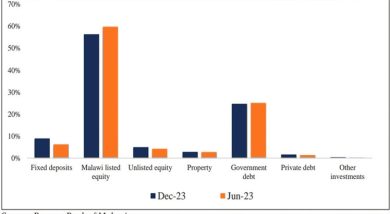Kwacha depreciation to stay on—WB
The World Bank (WB) says that the value of the country’s local unit, the kwacha, is likely to continue to depreciate against major trading currencies, especially the dollar, if the US currency continues to strengthen and inflation rates in Malawi remain higher.
The kwacha is currently trading at K720 in most authorised dealer banks (ADBs) and at around K750 on the parallel market.
In an interview with Weekend Nation, WB senior country economist Richard Record said while the overall trend towards depreciation in the value of the kwacha reflects uncertainties regarding Malawi’s macroeconomic outlook, kwacha depreciation has also been driven by a general strengthening of the US dollar relative to emerging and developing country currencies.
Said Record: “This is reflected by the kwacha’s relatively lower rate of depreciation against regional currencies such as the South African rand and the Zambian kwacha. The strengthening of the US dollar has been largely driven by expectations of an increase in the US Federal Reserve Bank’s reference lending rate, by concerns regarding the sustainability of resource-fuelled growth in developing economies led by Chinese demand, and by pressure on the Euro and British Pound after the Brexit vote in June.”
Malawi, an agro-based economy, experiences seasonality in the foreign exchange market, and the depreciation of the currency follows the seasonal nature of the market, with the period between September and March being a lean supply period largely due to the closure of the tobacco sales and is characterised by heavy importation of agricultural inputs such as fertiliser and fuel.
A decline in the value of the kwacha results in an increased import bill for strategic commodities such as fuel, fertiliser and pharmaceuticals.
Figures from the WB indicate that import cover in August stood at 4.1 months, unchanged from the same point in the previous year.
This is an increase from the figure of 3.6 months recorded in May 2016.
Early this year, the local unit showed signs of recovery to trade at around K724 against the US dollar from K730. But the depreciation was short-lived due to a poor tobacco marketing season and speculation.
The World Bank economist, however, urges government to control inflations to avoid further kwacha depreciation.
“A disappointing tobacco sales season and currency speculation have contributed to a shorter-than-usual period of moderated appreciation, with the average mid-exchange rate stabilising at K720 to the US dollar in August.
“Therefore, to prevent further dramatic depreciations, the control of domestic inflation is essential. In addition, the strong demand for food and fertiliser imports is expected to put pressure on the exchange rate and on foreign reserves, with proceeds from the export of tobacco being of critical importance,” he said.
Reserve Bank of Malawi (RBM) governor Charles Chuka is on record having said that the bank has done more work not only on monetary front, but also in ensuring that government borrowing—a contributing factor to rising inflation—reduces over time.
“Since the kwacha depreciated sharply last year, we have had to take a second look at the instruments we use to manage the kwacha. We have intensified our money market operations,” he said.
The kwacha was devalued in May 2012 by 49 percent to K250 to the dollar and thereafter allowed to be determined by market forces of demand and supply. The main objective was to correct once and for all the exchange rate misalignment and create long-term conditions for a more resilient, productive and exporting country.
By June 2013, the end of the 2012/2013 fiscal year, the kwacha had lost a further 32 percent to K330 to the dollar.
By November 2015, the kwacha had depreciated precipitously from K437 in June 2015 to K581 to the dollar in November 2015.
At close of the 2015, the Kwacha had lost value by 338 percent from K169 or 196 percent since the devaluation in May 2012.





